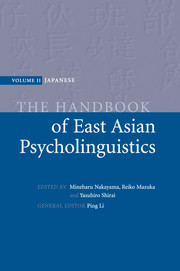Book contents
- Frontmatter
- Contents
- List of figures
- List of contributors
- In memory of Miwa Nishimura
- Preface
- Introduction
- Language acquisition
- 1 Ontogeny of language
- 2 Caregivers' speech
- 3 The intrinsic link between gesture and speech at the prelinguistic stage
- 4 Infant speech perception
- 5 Phonological acquisition
- 6 The mechanism of lexical development: implications from Japanese children's word learning
- 7 The acquisition of nouns and verbs in Japanese
- 8 The acquisition of verbal nouns
- 9 The acquisition of Japanese numeral classifiers
- 10 The acquisition of case markers
- 11 The acquisition of tense and aspect
- 12 On the origin of children's errors: the case of Japanese negation and direct passive
- 13 Binding Theory in UG and first-language acquisition of Japanese
- 14 The acquisition of the particles ne, yo, and no
- 15 The acquisition of linguistic politeness in Japanese
- 16 Children's narrative structures
- 17 Memory talk and testimony in children
- 18 Developmental dyslexia
- 19 Japanese Sign Language
- 20 The role of an innate acquisition device in second-language acquisition
- 21 Japanese, the grammar of reflexives, and second-language acquisition
- 22 Processes in L2 Japanese sentence production
- 23 The development of lexical competence among second-language readers
- 24 Reading in Japanese as a second language
- 25 Intrasentential code-switching in Japanese and English
- Part II Language processing
- References
- Name index
- Subject index
22 - Processes in L2 Japanese sentence production
from Language acquisition
Published online by Cambridge University Press: 05 June 2012
- Frontmatter
- Contents
- List of figures
- List of contributors
- In memory of Miwa Nishimura
- Preface
- Introduction
- Language acquisition
- 1 Ontogeny of language
- 2 Caregivers' speech
- 3 The intrinsic link between gesture and speech at the prelinguistic stage
- 4 Infant speech perception
- 5 Phonological acquisition
- 6 The mechanism of lexical development: implications from Japanese children's word learning
- 7 The acquisition of nouns and verbs in Japanese
- 8 The acquisition of verbal nouns
- 9 The acquisition of Japanese numeral classifiers
- 10 The acquisition of case markers
- 11 The acquisition of tense and aspect
- 12 On the origin of children's errors: the case of Japanese negation and direct passive
- 13 Binding Theory in UG and first-language acquisition of Japanese
- 14 The acquisition of the particles ne, yo, and no
- 15 The acquisition of linguistic politeness in Japanese
- 16 Children's narrative structures
- 17 Memory talk and testimony in children
- 18 Developmental dyslexia
- 19 Japanese Sign Language
- 20 The role of an innate acquisition device in second-language acquisition
- 21 Japanese, the grammar of reflexives, and second-language acquisition
- 22 Processes in L2 Japanese sentence production
- 23 The development of lexical competence among second-language readers
- 24 Reading in Japanese as a second language
- 25 Intrasentential code-switching in Japanese and English
- Part II Language processing
- References
- Name index
- Subject index
Summary
Overview
Though psycholinguists have made significant progress in understanding how first-language (L1) speakers produce sentences in speech, little is known about second-language (L2) sentence production processing (Heredia, 2003) and its development. This is partly because L2 research has focused upon the development of L2 knowledge, rather than real-time processing of that knowledge in performance (e.g. speaking). Paradoxically, however, most methods commonly adopted to study L2 knowledge often rely upon performance data (e.g. written/spoken). Analysis of such data to uncover L2 competence could benefit substantially from further research into L2 sentence processing.
Currently, research on L2 processing focuses almost exclusively on Indo-European languages, and few studies on L2 Japanese sentence production incorporate L1 psycholinguistic models. To situate L2 Japanese studies in a wider context, I will first review previous L2 sentence production research: L2 studies incorporating L1 sentence production models and L2 speech error studies referring to L1 speech error research. I will then briefly review studies on L1 Japanese speech errors involving case particles before discussing L2 Japanese production studies involving case particles.
Approaches in early L2 production research
Much early L2 production research primarily investigated temporal variables such as speaking rate and pause length (e.g. Dechert, Möhle & Raupach, 1984). These studies provided important observations about factors including automatization, but were primarily descriptive, rather than hypothesis-testing (e.g. Crookes, 1991).
- Type
- Chapter
- Information
- The Handbook of East Asian Psycholinguistics , pp. 158 - 164Publisher: Cambridge University PressPrint publication year: 2006



